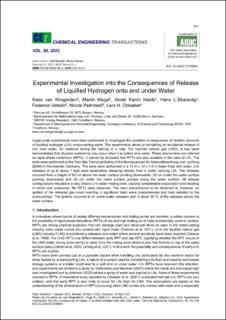| dc.contributor.author | van Wingerden, Kees | |
| dc.contributor.author | Kluge, Martin | |
| dc.contributor.author | Habib, Abdel Karim | |
| dc.contributor.author | Skarsvåg, Hans Langva | |
| dc.contributor.author | Ustolin, Federico | |
| dc.contributor.author | Paltrinieri, Nicola | |
| dc.contributor.author | Odsæter, Lars Hov | |
| dc.date.accessioned | 2022-07-21T08:22:06Z | |
| dc.date.available | 2022-07-21T08:22:06Z | |
| dc.date.created | 2022-06-15T12:31:09Z | |
| dc.date.issued | 2022 | |
| dc.identifier.citation | Chemical Engineering Transactions. 2022, 90 541-546. | en_US |
| dc.identifier.issn | 1974-9791 | |
| dc.identifier.uri | https://hdl.handle.net/11250/3007456 | |
| dc.description.abstract | Large-scale experiments have been performed to investigate the possible consequences of realistic amounts of liquified hydrogen (LH2) encountering water. The experiments aimed at simulating an accidental release of LH2 onto water, for instance during the fuelling of a ship. For liquified natural gas (LNG), it has been demonstrated that physical explosions may occur when it is spilled onto water. These phenomena are referred as rapid phase transitions (RPTs). It cannot be excluded that RPTs are also possible in the case of LH2. The tests were performed at the Test Site Technical Safety of the Bundesanstalt für Materialforschung und –prüfung (BAM) in Horstwalde, Germany. The tests were performed in a 10 m x 10 x 1.5 m basin filled with water. LH2 releases of up to about 1 kg/s were established releasing directly from a trailer carrying LH2. The releases occurred from a height of 50 cm above the water surface pointing downwards, 30 cm under the water surface pointing downwards and 30 cm under the water surface pointed along the water surface. All release configurations resulted in a very chaotic LH2-water mixing zone, causing considerable evaporation and resulting in minor over pressures. No RPTs were observed. The main phenomenon to be observed is, however, an ignition of the released gas cloud resulting in significant blast wave overpressures and heat radiation to the surroundings. The ignition occurred in all under-water releases and in about 90 % of the releases above the water surface. | en_US |
| dc.description.abstract | Experimental Investigation into the Consequences of Release of Liquified Hydrogen onto and under Water | en_US |
| dc.language.iso | eng | en_US |
| dc.publisher | AIDIC | en_US |
| dc.title | Experimental Investigation into the Consequences of Release of Liquified Hydrogen onto and under Water | en_US |
| dc.title.alternative | Experimental Investigation into the Consequences of Release of Liquified Hydrogen onto and under Water | en_US |
| dc.type | Peer reviewed | en_US |
| dc.type | Journal article | en_US |
| dc.description.version | publishedVersion | en_US |
| dc.rights.holder | AIDIC | en_US |
| dc.source.pagenumber | 541-546 | en_US |
| dc.source.volume | 90 | en_US |
| dc.source.journal | Chemical Engineering Transactions | en_US |
| dc.identifier.doi | 10.3303/CET2290091 | |
| dc.identifier.cristin | 2032082 | |
| dc.relation.project | Norges forskningsråd: 280964 | en_US |
| cristin.ispublished | true | |
| cristin.fulltext | original | |
| cristin.qualitycode | 1 | |
